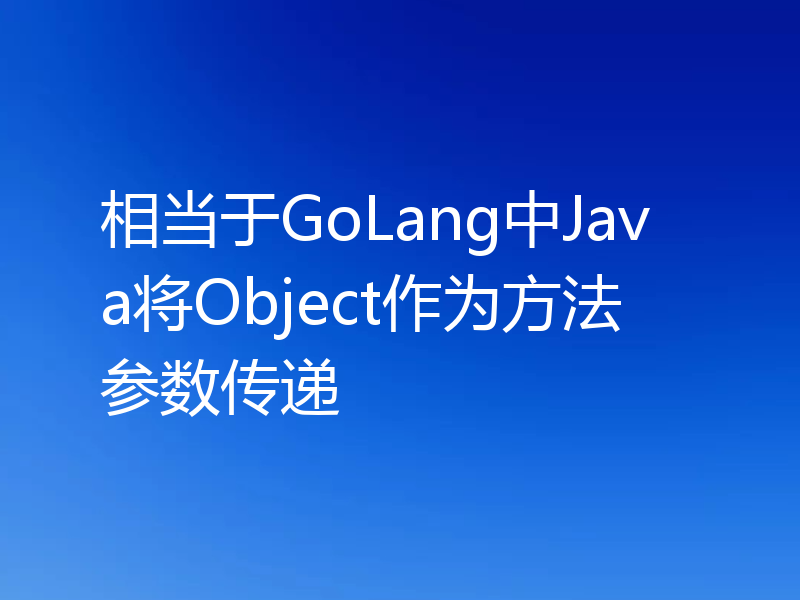使用 Go 泛型创建链式处理器
IT行业相对于一般传统行业,发展更新速度更快,一旦停止了学习,很快就会被行业所淘汰。所以我们需要踏踏实实的不断学习,精进自己的技术,尤其是初学者。今天golang学习网给大家整理了《使用 Go 泛型创建链式处理器》,聊聊,我们一起来看看吧!
我正在尝试在 go 中实现一种简单的处理管道,其中每个处理器都有确定的输入和输出类型,以及将当前处理器输出类型作为输入的后继处理器列表,并且可能具有其后继处理器拥有。
我遇到了如何将后继处理器添加到当前处理器的问题,无论其输出类型如何。我尝试使用 any 作为通配符类型,就像在 java 中使用 ? 一样,但 go 没有它。
我在 go 中拥有的是这样的:
type processor[inputtype any, outputtype any] struct {
nextprocessors []*processor[outputtype, any]
processingfunction func(inputtype) outputtype
}
func (b *processor[inputtype, outputtype]) process(input inputtype) {
result := b.processingfunction(input)
for _, nextprocessor := range b.nextprocessors {
nextprocessor.process(result)
}
}
func (b *processor[inputtype, outputtype]) addoutputprocessor(p *processor[outputtype, any]) {
b.nextprocessors = append(b.nextprocessors, p)
}
func main() {
outputer := processor[int, string]{processingfunction: func(input int) string {
print(input)
return string(input)
}}
doubler := processor[int, int]{processingfunction: func(input int) int { return input * 2 }}
rng := processor[int, int]{processingfunction: func(input int) int { return rand.intn(input) }}
rng.addoutputprocessor(&doubler)
doubler.addoutputprocessor(&outputer)
rng.process(20)
}
这给了我一个编译错误:
不能将 &doubler (类型 *processor[int, int] 的值)用作类型 *processor[int, any]
有没有办法忽略后继处理器的输出类型?或者我应该采取不同的方式来解决这个问题?我只是想确保后续处理器可以接受正确类型的输入。
作为参考,这里是 java 中的接口定义,它按照我的预期方式工作。
public interface Processor<InputType, OutputType> {
void addOutputProcessor(Processor<OutputType, ?> outputProcessor);
void process(InputType input);
}
public class Pipeline {
private abstract class BaseProcessor<InputType, OutputType> implements Processor<InputType, OutputType> {
List<Processor<OutputType, ?>> nextProcessors = new ArrayList<>();
abstract OutputType processHelper(InputType input);
@Override
public void addOutputProcessor(Processor<OutputType, ?> outputProcessor) {
nextProcessors.add(outputProcessor);
}
@Override
public void process(InputType input) {
OutputType result = processHelper(input);
for (Processor<OutputType, ?> nextProcessor : nextProcessors) {
nextProcessor.process(result);
}
}
}
private class RandomNumberGenerator extends BaseProcessor<Integer, Integer> {
@Override
Integer processHelper(Integer input) {
int generatedNumber = new Random().nextInt(input);
return generatedNumber;
}
}
private class IncrementProcessor extends BaseProcessor<Integer, Integer> {
@Override
Integer processHelper(Integer input) {
return input + 1;
}
}
private class DoubleProcessor extends BaseProcessor<Integer, Integer> {
@Override
Integer processHelper(Integer input) {
return input * 2;
}
}
private class Outputer extends BaseProcessor<Integer, String> {
String name;
public Outputer(String name) {
this.name = name;
}
@Override
String processHelper(Integer input) {
String output = String.format("Pipeline %s result: %d", name, input);
System.out.println(output);
return output;
}
}
public void buildAndRunPipeline() {
Processor<Integer, String> doublingOutputter = new Outputer("Doubling");
Processor<Integer, String> incrementingOutputter = new Outputer("Incrementing");
Processor<Integer, String> rngOutputter = new Outputer("Generating number");
Processor<Integer, Integer> doubler = new DoubleProcessor();
doubler.addOutputProcessor(doublingOutputter);
Processor<Integer, Integer> incrementer = new IncrementProcessor();
incrementer.addOutputProcessor(incrementingOutputter);
Processor<Integer, Integer> starter = new RandomNumberGenerator();
starter.addOutputProcessor(rngOutputter);
starter.addOutputProcessor(doubler);
starter.addOutputProcessor(incrementer);
starter.process(20);
}
public static void main(String[] args) {
Pipeline p = new Pipeline();
p.buildAndRunPipeline();
}
}
正确答案
没有。
在 go 中 any 只是一个静态类型(interface{} 的别名。它永远不能替代 java 的无界通配符 ?。所以 *processor[int, any] 与*processor[int, int] 并且您无法将一个分配给另一个,如错误消息所报告的那样。
为了构建任意长的链,您需要参数化 process 方法本身,但这在 go 1.18 中是不可能的。您必须在类型本身上声明所有类型参数。但是,即使您这样做,您仍会遇到不知道下一个处理器的输出类型的相同问题。
一般来说,使用 for 循环是行不通的,因为输入/输出值的静态类型不断变化。
我相信无需反思就能得到的最接近结果是通过顶级函数实现某种组合运算符 - 就像 haskell 中的 . 一样。但您必须手动嵌套调用。
一个简化的示例(processor 类型是多余的,但使其更接近您的代码):
package main
import (
"fmt"
"strconv"
)
type Processor[In, Out any] func(In) Out
func Process[In, Out any](input In, processor Processor[In, Out]) Out {
return processor(input)
}
func main() {
parser := Processor[string, int](func(input string) int { s, _ := strconv.Atoi(input); return s })
doubler := Processor[int, int](func(input int) int { return input * 2 })
outputer := Processor[int, string](func(input int) string { return fmt.Sprintf("%d", input) })
out := Process(Process(Process("20", parser), doubler), outputer)
fmt.Println(out)
}
演示:https://go.dev/play/p/Iv-virKATyb
本篇关于《使用 Go 泛型创建链式处理器》的介绍就到此结束啦,但是学无止境,想要了解学习更多关于Golang的相关知识,请关注golang学习网公众号!
 Goroutine 在使用通道时的执行顺序是什么?
Goroutine 在使用通道时的执行顺序是什么?
- 上一篇
- Goroutine 在使用通道时的执行顺序是什么?

- 下一篇
- (Golang) 处理和格式化列表中的 nils
-

- Golang · Go问答 | 1年前 |
- 在读取缓冲通道中的内容之前退出
- 139浏览 收藏
-

- Golang · Go问答 | 1年前 |
- 戈兰岛的全球 GOPRIVATE 设置
- 204浏览 收藏
-

- Golang · Go问答 | 1年前 |
- 如何将结构作为参数传递给 xml-rpc
- 325浏览 收藏
-

- Golang · Go问答 | 1年前 |
- 如何用golang获得小数点以下两位长度?
- 478浏览 收藏
-

- Golang · Go问答 | 1年前 |
- 如何通过 client-go 和 golang 检索 Kubernetes 指标
- 486浏览 收藏
-

- Golang · Go问答 | 1年前 |
- 将多个“参数”映射到单个可变参数的习惯用法
- 439浏览 收藏
-

- Golang · Go问答 | 1年前 |
- 将 HTTP 响应正文写入文件后出现 EOF 错误
- 357浏览 收藏
-

- Golang · Go问答 | 1年前 |
- 结构中映射的匿名列表的“复合文字中缺少类型”
- 352浏览 收藏
-

- Golang · Go问答 | 1年前 |
- NATS Jetstream 的性能
- 101浏览 收藏
-

- Golang · Go问答 | 1年前 |
- 如何将复杂的字符串输入转换为mapstring?
- 440浏览 收藏
-

- Golang · Go问答 | 1年前 |
- 相当于GoLang中Java将Object作为方法参数传递
- 212浏览 收藏
-

- Golang · Go问答 | 1年前 |
- 如何确保所有 goroutine 在没有 time.Sleep 的情况下终止?
- 143浏览 收藏
-

- 前端进阶之JavaScript设计模式
- 设计模式是开发人员在软件开发过程中面临一般问题时的解决方案,代表了最佳的实践。本课程的主打内容包括JS常见设计模式以及具体应用场景,打造一站式知识长龙服务,适合有JS基础的同学学习。
- 543次学习
-

- GO语言核心编程课程
- 本课程采用真实案例,全面具体可落地,从理论到实践,一步一步将GO核心编程技术、编程思想、底层实现融会贯通,使学习者贴近时代脉搏,做IT互联网时代的弄潮儿。
- 516次学习
-

- 简单聊聊mysql8与网络通信
- 如有问题加微信:Le-studyg;在课程中,我们将首先介绍MySQL8的新特性,包括性能优化、安全增强、新数据类型等,帮助学生快速熟悉MySQL8的最新功能。接着,我们将深入解析MySQL的网络通信机制,包括协议、连接管理、数据传输等,让
- 500次学习
-

- JavaScript正则表达式基础与实战
- 在任何一门编程语言中,正则表达式,都是一项重要的知识,它提供了高效的字符串匹配与捕获机制,可以极大的简化程序设计。
- 487次学习
-

- 从零制作响应式网站—Grid布局
- 本系列教程将展示从零制作一个假想的网络科技公司官网,分为导航,轮播,关于我们,成功案例,服务流程,团队介绍,数据部分,公司动态,底部信息等内容区块。网站整体采用CSSGrid布局,支持响应式,有流畅过渡和展现动画。
- 485次学习
-

- ChatExcel酷表
- ChatExcel酷表是由北京大学团队打造的Excel聊天机器人,用自然语言操控表格,简化数据处理,告别繁琐操作,提升工作效率!适用于学生、上班族及政府人员。
- 3201次使用
-

- Any绘本
- 探索Any绘本(anypicturebook.com/zh),一款开源免费的AI绘本创作工具,基于Google Gemini与Flux AI模型,让您轻松创作个性化绘本。适用于家庭、教育、创作等多种场景,零门槛,高自由度,技术透明,本地可控。
- 3414次使用
-

- 可赞AI
- 可赞AI,AI驱动的办公可视化智能工具,助您轻松实现文本与可视化元素高效转化。无论是智能文档生成、多格式文本解析,还是一键生成专业图表、脑图、知识卡片,可赞AI都能让信息处理更清晰高效。覆盖数据汇报、会议纪要、内容营销等全场景,大幅提升办公效率,降低专业门槛,是您提升工作效率的得力助手。
- 3444次使用
-

- 星月写作
- 星月写作是国内首款聚焦中文网络小说创作的AI辅助工具,解决网文作者从构思到变现的全流程痛点。AI扫榜、专属模板、全链路适配,助力新人快速上手,资深作者效率倍增。
- 4552次使用
-

- MagicLight
- MagicLight.ai是全球首款叙事驱动型AI动画视频创作平台,专注于解决从故事想法到完整动画的全流程痛点。它通过自研AI模型,保障角色、风格、场景高度一致性,让零动画经验者也能高效产出专业级叙事内容。广泛适用于独立创作者、动画工作室、教育机构及企业营销,助您轻松实现创意落地与商业化。
- 3822次使用
-
- GoLand调式动态执行代码
- 2023-01-13 502浏览
-
- 用Nginx反向代理部署go写的网站。
- 2023-01-17 502浏览
-
- Golang取得代码运行时间的问题
- 2023-02-24 501浏览
-
- 请问 go 代码如何实现在代码改动后不需要Ctrl+c,然后重新 go run *.go 文件?
- 2023-01-08 501浏览
-
- 如何从同一个 io.Reader 读取多次
- 2023-04-11 501浏览



